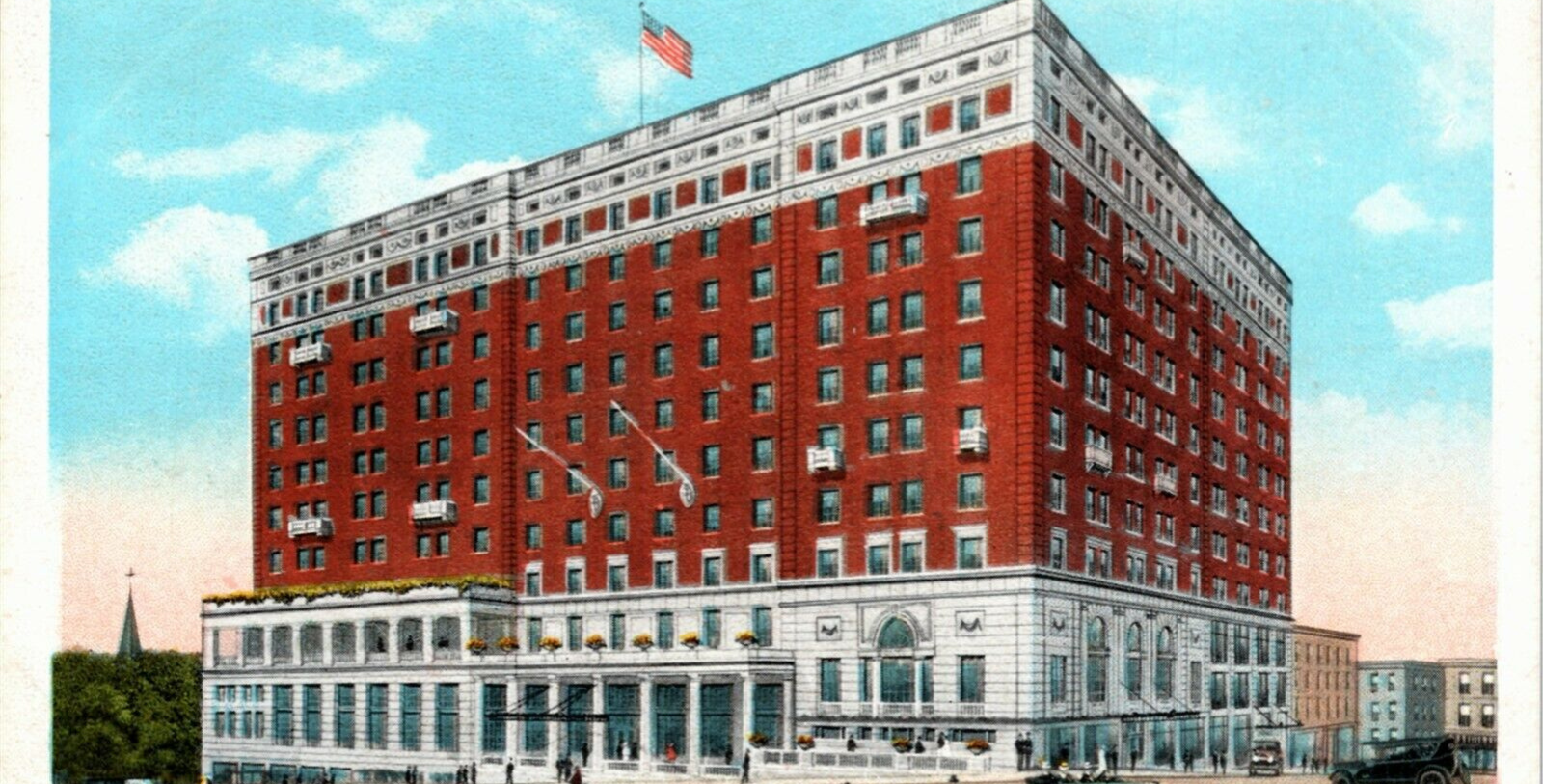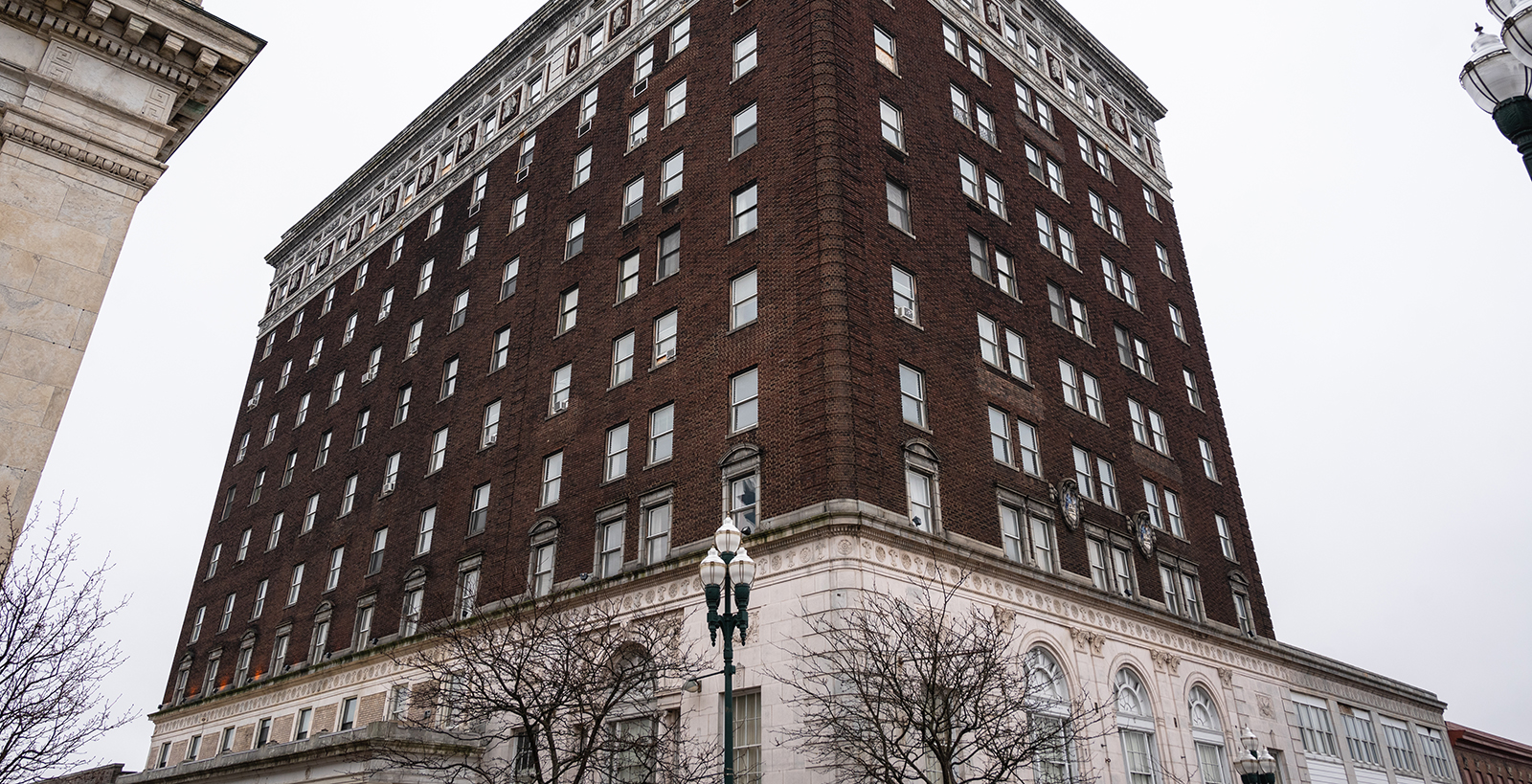Receive for Free - Discover & Explore eNewsletter monthly with advance notice of special offers, packages, and insider savings from 10% - 30% off Best Available Rates at selected hotels.
history
Discover The George Washington Hotel, which has hosted movie stars, business tycoons, and even U.S. Presidents.
The George Washington Hotel, a member of Historic Hotels of America since 2023, dates back to 1922.
VIEW TIMELINEBy the early 20th century, the city of Washington, Pennsylvania, had established itself as one of the most vibrant suburbs in the greater Pittsburgh metropolitan area. Along with strong mining and agricultural industries, Washington had benefited from rising levels of motor traffic on a portion of the historic National Road that cut through the center of town. Nevertheless, the heightened activity had also overwhelmed the city’s small boarding houses and taverns. To resolve the crisis, the Washington Chamber of Commerce began gathering resources to construct an upscale hotel in 1922. Its plan proved to be incredibly popular, as hundreds of residents purchased stock to help fund the building’s creation. Despite the excitement, the Washington Chamber of Commerce managed to remain focused and patient. It ultimately raised more than one million dollars in financing and arranged to have only the finest décor available. In fact, the group even recruited renowned architect William Lee Stoddart to design the structure. Stoddart and the Washington Chamber of Commerce subsequently worked together to construct a stunning ten-story edifice that dominated the local skyline. The beautiful building displayed a wealth of marvelous architectural details, from ornate limestone trim to maroon-colored brick. Fantastic amenities awaited inside, too, such as a grand ballroom, a movie theater, and 200 elegant guestrooms.
When construction finally concluded a year later, The Washington Chamber of Commerce decided to host a grand soirée to mark the hotel’s grand opening. Christening it “The George Washington Hotel” after the city’s namesake, U.S. President George Washington, the group arranged to hold the event on the anniversary of his birthday, February 22. In the years that followed, The George Washington Hotel emerged as a popular local gathering spot due to its unrivaled hospitality. This reputation reached a national audience over time, attracting many more guests from across the country. Among their number were influential figures like movie stars, business tycoons, and powerful politicians. Indeed, the guestbook gradually featured the names of countless celebrities, including Lou Gehring, Bob Hope, and Henry Ford. U.S. Presidents even visited The George Washington Hotel on occasion, such as John F. Kennedy, who watched an Army-Navy football at the building in 1962. The prosperity also enabled hotel management to constantly make structural improvements to the site that further enhanced its appeal. In 1935, for instance, the staff commissioned a prominent local artist named Malcom Parcell to create six murals for one of the dining venues called “The Pioneer Room.” Depicting artistic interpretations of the National Road and Washington, Parcell’s artwork became regarded as an important cultural attraction in just a matter of months.
The George Washington Hotel eventually underwent a period of decline around the beginning of the 1970s, which unfortunately lasted for decades. Despite several attempts to reverse its sagging fortunes, the hotel only continued to see its popularity dwindle. The building then began to transition away from being a hotel, serving first as a dormitory for the neighboring Washington & Jefferson College before finally becoming an assisted living facility. But by the end of the century, much of the erstwhile hotel sat unoccupied and derelict. Its fate uncertain, The George Washington Hotel was saved when preservationist Kyrk Pyros bought the entire site in 2003. He invested millions into resurrecting the structure, intent on restoring it back to its former historic glory. Taking four years to finish, Pyros and his team successfully reopened The George Washington Hotel with access to 30 exquisitely revitalized guestrooms. However, Pyros had also renovated the building to feature a wealth of upscale event spaces continue to enchant countless wedding parties today. A member of Historic Hotels of America since 2023, the future of this amazing historic hotel has never looked brighter. Cultural heritage travelers are certain to enjoy The George Washington Hotel’s revitalized guestrooms, terrific dining establishments, and opulent event facilities.
-
About the Location +
Located an hour south of Pittsburgh, the city of Washington, Pennsylvania, is replete with history. Indeed, the earliest known inhabitants of the area were a tribe of Lenape Native Americans. Led by a chieftain called “Tangooqua” and “Catfish,” the Lenape specifically built a remote outpost upon the site of present-day Washington. French explorers from Canada then started encountering the settlement in the mid-18th century, referring to it informally as “Wissameking,” or “catfish camp.” Word of the region eventually reached colonists down in Virginia, who began to settle it through a business called the “Ohio Company.” Possessing land grants known as “Virginia Certificates,” the pioneers quickly established farms and traded regularly with the Lenape. Over time, the Virginia legislature itself came to view the region as part of its own colonial jurisdiction. But neighboring Pennsylvania soon began challenging Virginia’s claim when members of its own population started settling the territory in the late 1760s. Primarily Scotch-Irish in background, the Pennsylvanians dramatically increased the amount of homesteads in the region. In fact, a few families had even moved onto the site of Catfish Camp, which they transformed into a small village. Nevertheless, Virginia and Pennsylvania finally resolved their longstanding dispute during the American Revolution, with the former ceding its territorial claims to the latter in 1781. Pennsylvania then set about organizing the area into Washington County and used Catfish Camp as the administrative seat.
A land surveyor named David Hoge arrived not long thereafter to develop Catfish Camp into an actual town. He subsequently established a street grid and divided the corresponding lots for commercial and residential development. The reborn community grew gradually over next few years, adopting names like “Bassett” and “Dandridge Town” before becoming “Washington.” Much of the town’s growth had occurred thanks to a prosperous agricultural sector that was sustained mainly by the cultivation of grain and its distillation into whiskey. Local farmers then traded those goods west along the Ohio River, since traveling east through Allegheny Mountains was too expensive. In consequence, everyone in Washington County felt a strong sense of independence. But this autonomy also fomented tension with state and federal authorities, especially once the 1791 Excise Whiskey Tax went into effect. Passed to pay the national debt incurred to fight the American Revolutionary War, the federal tax targeted the lucrative sale of whiskey as a way to generate revenue. But it inflamed people throughout western Pennsylvania, particularly those residing in Washington and Washington County. They quickly formed a largescale uprising and began assaulting tax collectors over the span of three years. President Washington eventually marched into Washington County alongside 13,000 militiamen, but was able to put the revolt down peacefully. Known today as the “Whiskey Rebellion,” the event solidified the premise that the federal government could institute its own taxes.
Both Washington and Washington County lost their frontier character in the decades after the Whiskey Rebellion. In fact, Washington expanded into a prosperous city throughout the 19th and 20th centuries. Much of this development initially transpired due to the incredibly important National Road, which the U.S. Congress had constructed during the early 1800s. Linking its way up north from Maryland, the road introduced an unprecedented amount of visitor travel into Washington that persisted for generations. (This section of the thoroughfare still exists today as U.S. Route 40.) More recently, Washington has thrived as a suburb of Pittsburgh, placing it in the center of one of the nation’s most important economic hubs. But Washington has also emerged as a top cultural heritage destination, as it is home to many outstanding attractions like the Bradford House Museum, the Pennsylvania Trolley Museum, and Washington and Jefferson College—a renowned liberal arts institution founded around the same time as the city. Guests visiting Washington have also thoroughly enjoyed its proximity to Pittsburgh and its countless landmarks, such as the Point State Park, the Carnegie Museums of Pittsburgh, and the Phipps Conservatory & Botanical Gardens. Washington is close to many other historical sites, too, such as Fort Necessity National Battlefield, the Flight 93 National Memorial, and Frank Lloyd Wright’s Fallingwater. Few places in the country have a more interesting story than Washington, Pennsylvania.
-
About the Architecture +
When the renowned architect William Lee Stoddart first designed The George Washington Hotel during the Roaring Twenties, he chose Beaux-Arts architecture as the main source of his inspiration. While Beaux-Arts architecture itself became widely popular throughout the United States at the beginning of the 20th century, its origins actually date much further back in time. Indeed, this beautiful architectural form first emerged at a Parisian art school known as the “École des Beaux-Arts” during the 1830s. There was much resistance to the Neoclassism of the day among French artists, who yearned for the intellectual freedom to pursue less rigid design aesthetics. Four instructors in particular were responsible for establishing the movement: Joseph-Louis Duc, Félix Duban, Henri Labrouste, and Léon Vaudoyer. The training that these instructors curated involved fusing architectural elements from several earlier styles, including Imperial Roman, Italian Renaissance, ad Baroque. As such, a typical building created with Beaux-Arts-inspired designs would feature a rusticated first story, followed by several more simplistic ones. A flat roof would then top the structure. Symmetry became the defining character, with every building’s layout featuring such elements like balustrades, pilasters, and cartouches. Sculptures and other carvings were commonplace throughout the design, too. Despite the beauty of Beaux-Arts, the architectural style only obtained a following in France—most other European architects had gravitated toward British design principles. However, Beaux-Arts eventually found an eager audience in the United States several decades later, with many American architects—like the great William Lee Stoddart—including its aesthetics into their work. Beaux-Arts architecture has thus been identified as of the most historically influential architectural styles in America history.
-
Famous Historic Guests +
Al Capone, known as “Scarface”, infamous mob boss of the Chicago Outfit
Bob Hope, comedian and patron of the United Service Organization (USO).
Marilyn Monroe, actress known for her roles in Bus Stop and Some Like It Hot.
Joan Blondell, actress known for her roles in films like The Blue Veil, Opening Night, and The Champ.
Ernestine Schumann-Heink, operatic contralto noted for the diverse range of her voice.
Harry James, big band leader known for working alongside the likes of Frank Sinatra, Benny Goodman, and Louie Bellson.
The Beatles, legendary rock band consisting of George Harrison, John Lennon, Paul McCartney, and Ringo Starr.
The Monkees, a pop-rock band consisting of Mickey Dolenz, Davy Jones, Mike Nesmith, and Peter Tork.
Lowell Thomas, journalist and filmmaker who founded the widescreen process known as “Cinerama.”
Lou Gehring, Hall of Fame first baseman for the New York Yankees (1923 – 1939)
Mickey Mantle, Hall of Fame outfielder for the New York Yankees (1951 – 1968)
Henry Ford, founder of the Ford Motor Company.
Richard Byrd, aviator and Medal of Honor recipient known for exploring a segment of the Antarctic Plateau.
Sir Ronald Lindsay, British Ambassador to the United States (1930 – 1939)
Harry S. Truman, 33rd President of the United States (1945 – 1953)
John F. Kennedy, 35th President of the United States (1961 – 1963)
-
Film, TV and Media Connections +
The Dark Half (1993)
Mindhunter (2017)

































